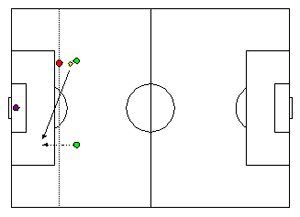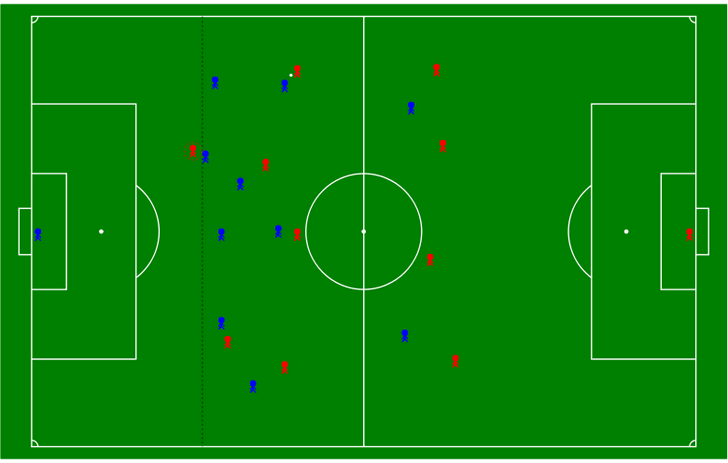The offside rule is one of the most controversial rules in football, used for years by chauvinists to suggest that girls don’t know about football if they can’t explain it.
Yet what exactly is the rule? Why and when was it introduced? How has it changed over the years?
Grab your salt shaker and your pepper pot, we’re about to delve into the confusing world of two men behind the ball and interfering with play.
When Was the Offside Rule Introduced?

When football was first played it was a cross between the game we know today and the sport we more commonly know as rugby. It was played by a different set of rules depending on where you went to school or where about in the country you lived.
Before the formation of the Football Association and an attempt to formalise the rules of the game most universities and even school played by the Cambridge Rules. These stated that a player was not allowed to touch the ball if he was standing in front of it, similar to the rules imposed in rugby nowadays.
When the Football Association drafted the Laws Of The Game in 1863 it stated that no forward passes were allowed at all unless the ball was hit from behind the goal line. These rules were only adopted by the followers of what was known as the London Football Association, however, with the Sheffield Football Association having a rule that was more similar to the offside law we know today.
The Sheffield Rules stated that one member of the opposition team must be between an attacker and the goal, whilst the Cambridge Rule declared it must be ‘more than three’. When the Laws Of The Game were amended in 1866 a compromise was found, with the Cambridge Rule adopted with the change that ‘at least three players’ were needed rather than ‘more than three’.
In 1925 the rule changed to ‘two opponents’ rather than three and a marked increase in the amount of goals scored occurred. In the 1924-1925 season 4700 goals were scored across 1848 Football League matches. The following season this rose to 6373 goals from the same number of matches.
What Is Current Offside Rule?

In 1990 an amendment was made to the offside rule to declare that a player was onside if they were level with the penultimate opponent that they faced. That means that if any part of the attacking player that can legally score a goal is closer to the goal than the second-to-last player of the defending team then the attacking player is offside.
There are three other important points that need to be born in mind when discussing whether or not a player is offside:
- A player cannot be offside if he is in his own defensive half of the field.
- Being offside is not, in itself, an offence. It only becomes one if the player attempts to touch the ball after it has been played forward by a team-mate.
- The opposition’s goalkeeper counts as one of the players, but he doesn’t have to be one of their players
That last point can be slightly confusing so we’ll explain it further. To be onside there must be two players between the attacking player and the opposition’s goal. Normally the opposition’s goalkeeper is naturally one of those players as he is more likely than not the furthest player back during any phase of play. Sometimes, however, a goalkeeper may run up for his team’s attacking corner, if they’re chasing the game, for example, and when that happens an attacking player will still be onside as long as two players from the other team are between him and the goal.
The most crucial moment for an offside decision is the moment that the ball is struck by the player passing the ball. The player he is attempting to pass to can be stood in offside decision up until the moment the pass is made, but when the ball leaves his foot or head the attacking player needs to be level with the penultimate player.
Another thing to remember is that offsides aren’t an offence in the same way as a foul or a handball, for example. A player can be offside as many times as he’d like during a game and won’t be booked or sent off for it. He might incur the wrath of the crowd, though, with supporters likely to become extremely agitated over repeated offside calls. Mario Ballotelli is a player who specialises in such things.
Changes To The Offside Rule
 There are often slight changes to the offside rule as the game’s governing body attempts to keep up with the speed and advancement of the game. Recently an amendment was made to the rule that stated a player could be offside if he ‘interfered with play’, as an example. That is to say, a player might be stood in an offside position but not touch the ball and yet still be given offside because his positioning meant that he prevented a defensive player from being able to see the ball clearly.
There are often slight changes to the offside rule as the game’s governing body attempts to keep up with the speed and advancement of the game. Recently an amendment was made to the rule that stated a player could be offside if he ‘interfered with play’, as an example. That is to say, a player might be stood in an offside position but not touch the ball and yet still be given offside because his positioning meant that he prevented a defensive player from being able to see the ball clearly.
In recent times that has been taken even further, with a player adjudged to be onside if he’s in an offside position but doesn’t make any attempt to play the ball. The second a movement is made that indicates the player is trying to get a touch on the ball he becomes ‘active’ and can be judged to be offside.
Whilst supporters may, understandably, become annoyed with officials who get offside calls wrong it is important to remember that they’re only human. Something we wouldn’t have been able to type had Howard Webb still been officiating. The reality is that players can move so quickly nowadays and so much can be going on at the same time – with officials having to look for the movement of the attacking player as well as the moment that the ball is touched – that it’s actually quite remarkable that officials don’t get more offside calls incorrect than is currently the case.
Of course, if VAR is being used then a player might be flagged as offside if their little finger is in front of the defender – but that’s another article.
